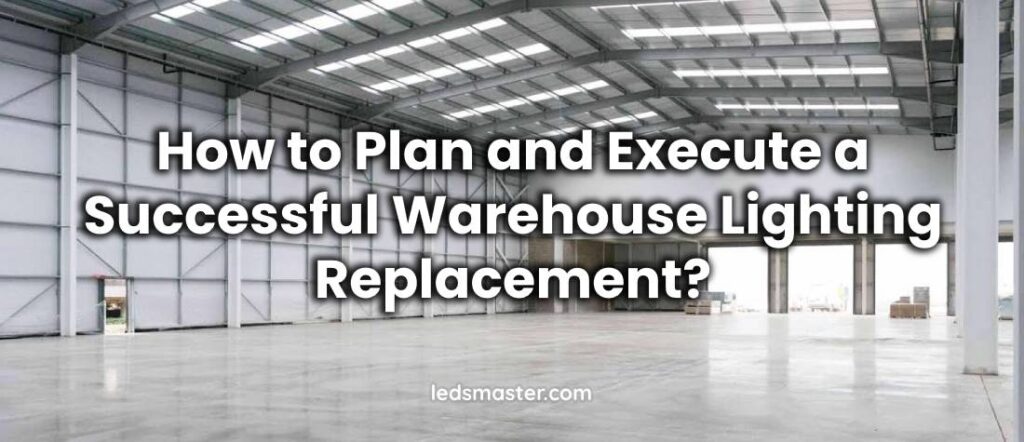Warehouse lighting ensure visibility, safety, and energy efficiency in a warehouse environment. Over time, existing lighting systems may become inefficient or outdated, leading to higher energy consumption and maintenance costs. As the demands on warehouse operations evolve, it becomes necessary to reassess the lighting system. Whether it’s due to the aging of current fixtures or the desire to upgrade to more energy-efficient options, planning the replacement of warehouse lights requires careful attention.
Table of Contents
ToggleSetting Goals for Your Warehouse Lighting Replacement
Before beginning the replacement process, it’s important to define clear objectives. Determine whether the goal is to reduce energy costs, improve the quality of light, or upgrade to newer, more durable technology. Setting these goals will help in selecting the right lighting solution that aligns with the needs of your warehouse. Another consideration may be meeting industry standards for illumination in various areas of the warehouse.
Choosing the Right Lighting Technology
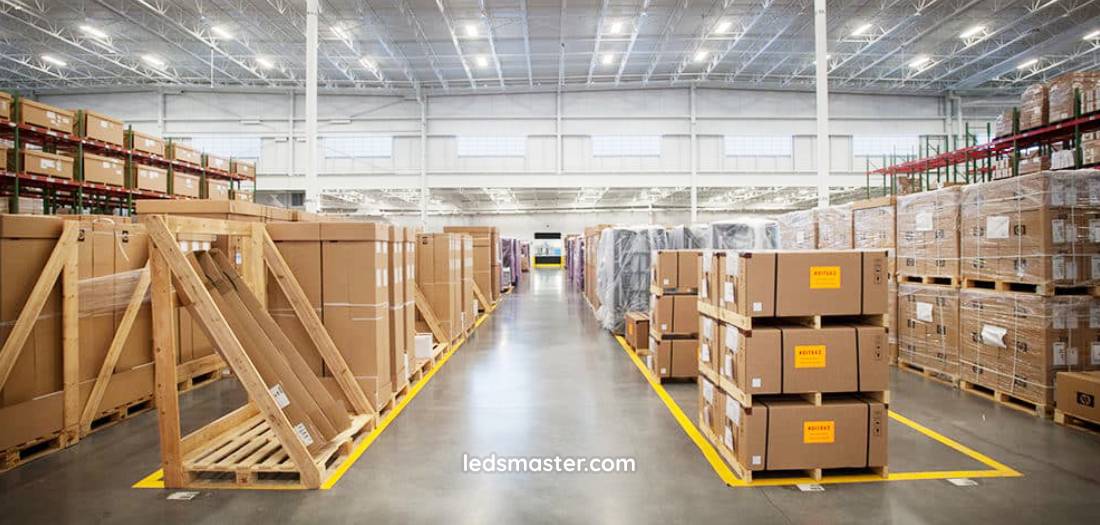
When selecting new lighting for a warehouse, it’s important to consider several factors such as energy efficiency, light quality, longevity, and total cost of ownership. Various lighting technologies are available, each offering distinct advantages depending on the specific needs of the warehouse. Among the most popular options are LED, fluorescent, and halogen lighting, each of which has its own strengths and weaknesses. The choice of lighting should align with the goals of reducing energy consumption, minimizing maintenance costs, and meeting the lighting requirements for different tasks within the warehouse.
LED lighting has emerged as one of the most popular choices in recent years due to its many advantages, such as energy efficiency, longer lifespan, and lower maintenance costs. Fluorescent and halogen lighting, though offering a lower initial cost, may result in higher ongoing energy consumption and more frequent maintenance. When deciding on the best lighting solution for your warehouse, it’s important to weigh factors like light output, energy consumption, initial costs, and how the lighting will support the daily operations of the warehouse.
LED Lighting: A Modern Solution
LED (Light Emitting Diode) lighting has quickly become the standard for warehouses due to its outstanding energy efficiency and long lifespan. LED technology uses much less energy compared to traditional incandescent or fluorescent lighting, which results in significant savings on electricity bills. One of the key advantages of LED lighting is its ability to deliver high light output with minimal heat generation. This makes it an ideal option for large warehouses that require consistent, bright lighting without overheating the space.
The efficiency of LED lights is particularly beneficial in environments like warehouses, where lights are often kept on for long hours. Compared to incandescent bulbs, which waste a large portion of energy as heat, LEDs use most of the energy to produce light. As a result, they offer a much higher lumen output per watt, which helps reduce overall energy consumption. Additionally, LEDs have a significantly longer lifespan, typically ranging from 50,000 to 100,000 hours, reducing the need for frequent bulb replacements and maintenance. This can be especially important in a warehouse setting where maintenance costs and downtime can be disruptive to operations.
While the initial cost of LED fixtures may be higher than traditional options like fluorescent or halogen lighting, the long-term savings on energy and maintenance costs often make them the most cost-effective option. Over time, these savings can offset the higher upfront investment. Furthermore, with advancements in LED technology, the range of lighting options available, including dimming capabilities and tunable color temperatures, allows for even greater customization of lighting in the warehouse to suit specific tasks or areas.
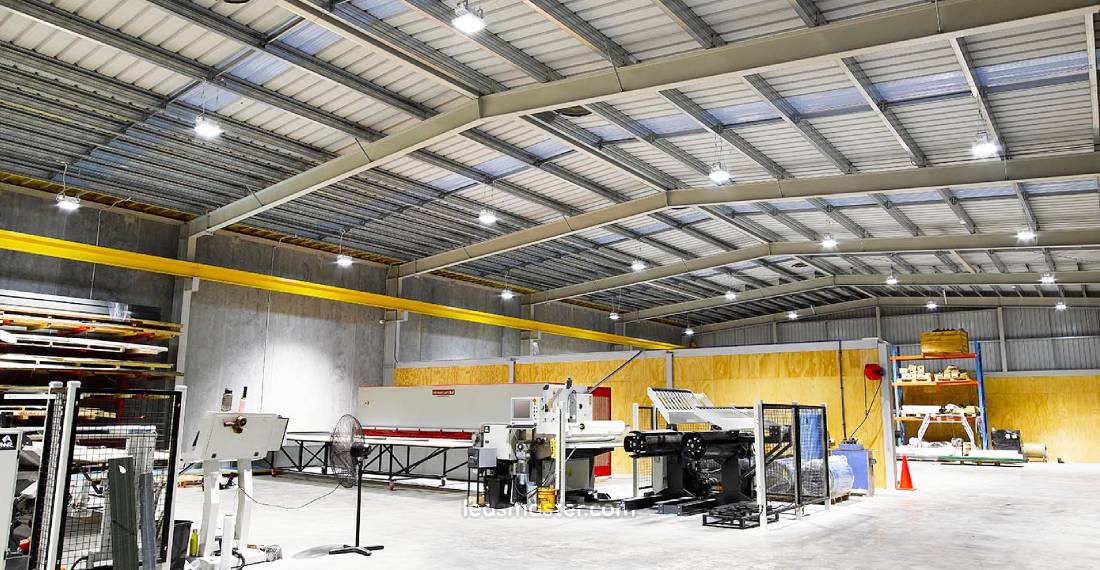
Fluorescent Lighting: An Affordable Option
Fluorescent lighting is another popular option when replacing warehouse lighting, and it can be a more affordable choice upfront than LEDs. These lights are widely used in warehouses due to their relatively low cost and ability to provide adequate illumination. Fluorescent lights are available in both tube and compact formats, which makes them versatile for different types of warehouse layouts. However, while they offer reasonable energy efficiency, they are still not as efficient as LEDs.
Fluorescent lights tend to use more energy than LED lights and require frequent bulb replacements, which increases long-term maintenance costs. Fluorescent bulbs typically last around 10,000 to 20,000 hours, which is much shorter than LED lights. Over time, the cost of replacing bulbs and dealing with ballast failures can add up. In addition, fluorescent lighting can also be prone to flickering and often requires a warm-up period, which can be problematic in a busy warehouse environment where consistent lighting is crucial.
Despite these downsides, fluorescent lighting can still be a viable option for warehouses operating on a tight budget. If upfront costs are a concern and you are looking for a more economical solution for the short term, fluorescent lighting may be a suitable choice. However, as the need for energy efficiency and reduced maintenance becomes more important, transitioning to LED lighting may be a more worthwhile long-term investment.
Halogen Lighting: Traditional and Bright, But Less Efficient
Halogen lighting, a type of incandescent bulb, is often used in areas where a very bright, focused light is needed. While halogen lights offer a bright, white light with good color rendering, they are the least energy-efficient option compared to LEDs and fluorescent lights. Halogen bulbs emit a significant amount of heat, which can make them unsuitable for larger warehouses or areas with poor ventilation. Additionally, their energy consumption is much higher than that of LEDs or fluorescent bulbs, leading to higher electricity costs over time.
Halogen lights have a shorter lifespan than both LEDs and fluorescents, typically lasting around 2,000 to 3,000 hours. This can be problematic in a warehouse setting, where lights are often left on for extended periods. The frequent need to replace bulbs adds to maintenance costs and can lead to unnecessary downtime. Despite these drawbacks, halogen lights are still used in warehouses where spotlights or task lighting are needed, but they are generally not recommended for general lighting in larger spaces.
Choosing Between Lighting Options
When choosing the right lighting technology for a warehouse, it is essential to consider the specific needs of the space. For general warehouse lighting, LED lighting is often the best choice due to its superior energy efficiency, long lifespan, and low maintenance requirements. Fluorescent lighting may be appropriate for warehouses on a limited budget or for temporary use, while halogen lights should be reserved for specific tasks or areas requiring focused lighting.
In addition to the type of lighting, the layout of the warehouse, the activities performed within the space, and the specific lighting levels required should all factor into the decision-making process. For instance, high-bay warehouses with tall ceilings may benefit from the high lumen output and directional nature of LED lights, while areas with lower ceilings might perform well with fluorescent lighting. The use of dimming controls, motion sensors, and other smart lighting features can further optimize the lighting system for energy savings and operational efficiency.
Ultimately, the right lighting choice will depend on your warehouse’s specific needs, budget, and long-term goals. While LED technology stands out as a strong choice for most modern warehouses, understanding the pros and cons of all available options will help you make a well-informed decision that aligns with your operational objectives.
Calculating the Lighting Requirements for Your Warehouse
 Every warehouse has unique lighting needs, shaped by its size, layout, and the nature of the work being performed. Properly calculating the lighting requirements for a warehouse involves evaluating different areas based on how they are used and ensuring that lighting levels are appropriate for each task. Warehouse lighting is not a one-size-fits-all solution; it requires careful consideration of factors such as work area type, the duration of light usage, and the number of personnel working in the space. For example, areas where precise tasks are performed, such as packaging lines, assembly stations, or inspection areas, may need brighter, more focused lighting. On the other hand, storage areas or aisles, where less detailed work is done, may require lower light levels.
Every warehouse has unique lighting needs, shaped by its size, layout, and the nature of the work being performed. Properly calculating the lighting requirements for a warehouse involves evaluating different areas based on how they are used and ensuring that lighting levels are appropriate for each task. Warehouse lighting is not a one-size-fits-all solution; it requires careful consideration of factors such as work area type, the duration of light usage, and the number of personnel working in the space. For example, areas where precise tasks are performed, such as packaging lines, assembly stations, or inspection areas, may need brighter, more focused lighting. On the other hand, storage areas or aisles, where less detailed work is done, may require lower light levels.
In addition to light levels, other factors like lighting density, uniformity, and color temperature must also be factored into the decision-making process. Lighting density refers to the number of lumens produced by the light source in relation to the area it covers, which directly impacts how effectively the space is illuminated. Uniformity ensures that the light is evenly distributed across all areas of the warehouse, minimizing shadows and hotspots. Color temperature, typically measured in Kelvins (K), also plays a role in how workers perceive the lighting in the warehouse, influencing their comfort and productivity.
Evaluating Light Levels
One of the most important considerations when replacing warehouse lighting is ensuring that the new system meets the appropriate light levels for the specific tasks being performed. Light levels are typically measured in lux (or foot-candles in the U.S.), and each area of the warehouse will have different illumination requirements based on the activities conducted in that space. For instance, aisles or general storage areas might require light levels in the range of 100 to 300 lux, which is adequate for moving around safely and finding goods. However, workstations, where workers are performing more intricate tasks such as assembly or quality inspection, will need much higher levels of light, typically ranging from 500 to 1000 lux or more, depending on the task’s complexity.
It’s also important to note that light levels should not only meet the minimum requirements for the work but also support the comfort and safety of employees. Insufficient lighting can strain the eyes and lead to mistakes, while excessive lighting can create glare, leading to discomfort and potential safety hazards. Conducting a thorough lighting assessment can help ensure that each area of the warehouse is adequately lit to support both operational efficiency and worker wellbeing.
Ensuring Uniformity in Lighting Distribution
Another important factor when planning a warehouse lighting replacement is achieving uniformity in light distribution across the entire space. Uniformity refers to how evenly the light is spread across the warehouse floor. Poorly distributed lighting can lead to areas of excessive brightness and dark, shadowy spots. These discrepancies in lighting can lead to visual discomfort for workers and even increase the risk of accidents in low-light areas. Inadequate lighting in some areas can also reduce worker productivity, as employees may struggle to perform tasks in poorly lit sections.
To achieve uniform lighting distribution, it’s important to properly place light fixtures in areas where light levels need to be more intense, such as workstations, and reduce lighting in less critical areas like aisles or storage areas. A combination of light fixtures placed at the correct angles, with the right spacing, will ensure even illumination across the warehouse floor. The use of lighting simulations during the planning phase can help visualize how light will be distributed and make it easier to identify any potential problems with uneven lighting before the installation begins.
Planning the Installation Process
After choosing the ideal lighting solution for your warehouse, the next crucial step is to plan the installation process. Proper planning ensures that the new lighting system is installed efficiently, without unnecessary disruptions to warehouse operations. The scale of the installation and the complexity of the new system will determine whether you need professional electricians or specialized contractors to assist with the installation. A warehouse lighting upgrade is not just a simple switch of fixtures; it often involves a detailed setup of wiring, electrical components, and ensuring compliance with safety and building codes.
One of the most important considerations during the planning phase is minimizing operational disruption. Installing a new lighting system in a large warehouse can cause significant downtime if not managed correctly. The installation should be scheduled during off-peak hours, when the warehouse is not in full operation, or during periods when the workload is lighter. This allows the work to be done efficiently while maintaining productivity. Careful planning will also help prevent any delays in completing the project, so that the new lighting system can be up and running as quickly as possible.
The installation process itself should not only focus on the technical aspects but also on ensuring that the new system meets the required lighting levels and distribution. Coordinating with the installation team to verify the placement of each fixture and ensuring that the power supply is adequate for the new system is crucial for the success of the project. Taking these steps during the planning phase will help avoid issues that may arise during or after installation, such as inconsistent light distribution or power overloads.
Scheduling the Installation
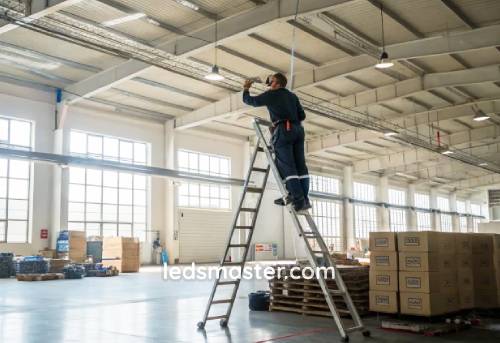 Scheduling the installation is one of the most critical aspects of the planning process. It’s important to ensure that the installation takes place at a time when it will cause the least disruption to day-to-day warehouse activities. For warehouses operating on a standard business schedule, it’s often best to arrange the installation for evenings or weekends, when staff is not working, and the warehouse is not in full use. However, for warehouses that operate 24/7 or have constant activity, this may not be possible. In such cases, the installation may need to be broken into phases.
Scheduling the installation is one of the most critical aspects of the planning process. It’s important to ensure that the installation takes place at a time when it will cause the least disruption to day-to-day warehouse activities. For warehouses operating on a standard business schedule, it’s often best to arrange the installation for evenings or weekends, when staff is not working, and the warehouse is not in full use. However, for warehouses that operate 24/7 or have constant activity, this may not be possible. In such cases, the installation may need to be broken into phases.
Phase-based installation can be an effective solution for warehouses with continuous operations. By breaking the project into manageable sections, you can ensure that parts of the warehouse continue to have sufficient lighting during the installation process. For example, one section of the warehouse can be fully equipped with new lighting while work continues in other areas with the existing system in place. This staggered approach allows for minimal disruption to ongoing operations and ensures that no areas of the warehouse are left in the dark.
If your warehouse is undergoing a significant overhaul of its lighting system, it’s also a good idea to communicate with all relevant stakeholders about the installation timeline. Staff members, supervisors, and other departments should be informed of the installation schedule, so they are prepared for potential changes to workflow or working conditions during installation. By keeping everyone in the loop, you can ensure a smoother transition to the new lighting system.
In addition to considering operational impacts, it’s also necessary to schedule any inspections or regulatory checks that might be required. Depending on your location, there may be building codes or safety regulations that need to be followed during the installation process. Coordinating with local authorities or building inspectors in advance can help avoid delays caused by missing documentation or compliance issues.
Coordinating with Contractors and Electrical Teams
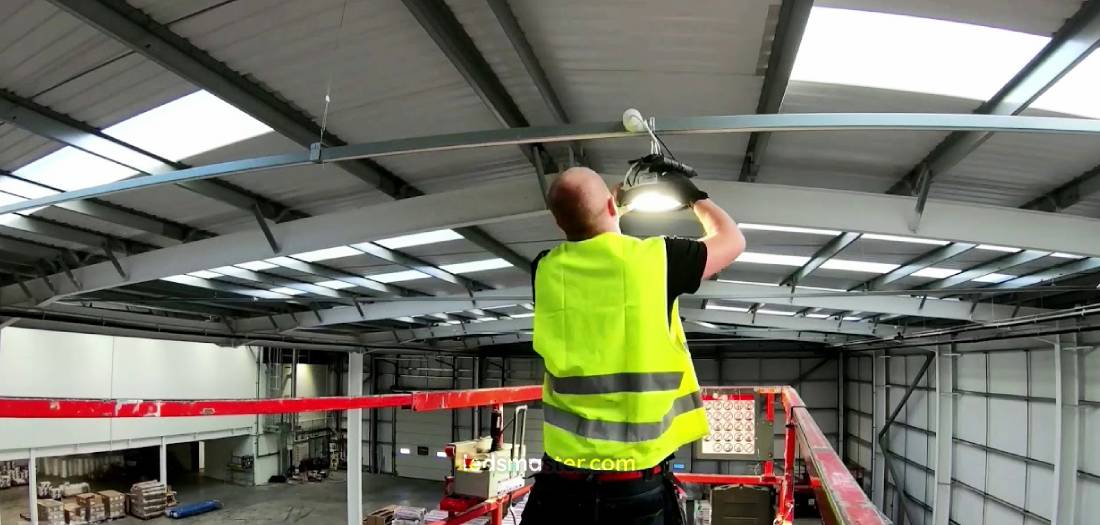
In many cases, installing a new warehouse lighting system requires the expertise of professional electricians or specialized contractors. Coordinating with these professionals ahead of time is key to a smooth installation process. If your warehouse lighting plan involves complex electrical work, such as rewiring or upgrading the power system, hiring experienced contractors will ensure that the work is completed safely and to the required standards.
The installation team should be briefed thoroughly on the lighting plan before work begins. This includes details such as the placement of fixtures, the power requirements for each area, and any specific challenges related to the warehouse’s layout or operations. For instance, high-ceiling areas may require lifts or scaffolding to install lighting fixtures, while areas with sensitive equipment may require special care to avoid interference. Ensuring that all parties are aligned on these logistics before the installation starts will help prevent delays and ensure that the system works as planned.
Moreover, it’s a good idea to schedule a final walkthrough of the installation site before work begins. This allows you to assess the site, review the placement of fixtures, and ensure that everything is set up according to the design plan. If any adjustments need to be made, this is the time to address them, rather than waiting until after installation is completed. A thorough walkthrough also ensures that the installation team is fully aware of any specific safety or access considerations during the process.
Preparing for Installation Day
The day of installation should be meticulously planned to ensure everything runs smoothly. Prior to the start of installation, the warehouse should be prepared by clearing any areas that might be obstructed by equipment or installation teams. This may involve temporarily moving goods, machinery, or shelving to give contractors easy access to installation zones. Furthermore, any equipment that is sensitive to power surges or electrical issues should be turned off or protected to prevent damage.
Having all necessary tools, materials, and lighting fixtures on hand before the installation begins is vital. This includes ensuring that all the light fixtures, wiring components, ballasts, and any other necessary materials are delivered to the site in advance. Delays in the arrival of supplies can result in downtime, which should be avoided to minimize the disruption to your warehouse operations.
Minimizing Downtime During Installation
One of the primary goals during the installation process is minimizing downtime, both in terms of the actual time it takes to install the system and the potential disruptions to warehouse operations. Aside from scheduling the installation during off-hours or breaking it into phases, it’s important to set clear expectations with the installation team regarding the project timeline. Make sure to allocate enough time for the installation to be completed without rushing the contractors, as this could result in mistakes or incomplete installations.
During the installation process, close monitoring of the work is essential. Assigning a project manager or a member of your team to oversee the progress ensures that any issues are identified and addressed quickly. Having a point of contact for both the contractors and the warehouse management team helps keep the process moving efficiently. Any unexpected issues, such as equipment failures or delays in deliveries, should be resolved promptly to avoid prolonging the installation timeline.
Maintaining the New Lighting System
After the warehouse lighting replacement is complete, ongoing maintenance will be required to ensure the system continues to operate at peak efficiency. Regular inspections of the fixtures and the lighting controls are recommended to identify any issues, such as flickering lights or bulbs that need replacement. Proper maintenance extends the lifespan of the lighting system and ensures that energy consumption remains low.
Regular Inspection and Cleaning
Regular cleaning and inspection of the new lighting fixtures can help maintain their effectiveness. Dust and debris can accumulate on light fixtures, reducing the amount of light output. Regularly cleaning the fixtures and ensuring they are free from obstruction can optimize their performance. In addition, check for any signs of malfunction, such as flickering bulbs or dimming, and replace faulty components promptly to avoid further issues.
Upgrading the System Over Time
As technology continues to evolve, consider upgrading the lighting system as newer, more energy-efficient options become available. Stay informed about advancements in lighting technologies, such as smart lighting systems that can be remotely controlled and monitored. Over time, these systems may offer additional savings and improvements in lighting performance.
Conclusion
Planning and executing a warehouse lighting replacement requires thoughtful preparation, from evaluating the existing system to selecting the right technology and installation methods. By taking the time to understand the lighting needs of your warehouse, choosing energy-efficient solutions, and ensuring proper maintenance, warehouse owners can enjoy better visibility, improved safety, and reduced operational costs. The process may seem complex, but with careful planning, it can be a rewarding investment that enhances the overall efficiency of warehouse operations.

